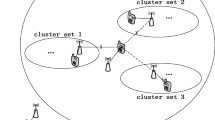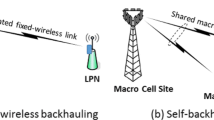Abstract
Coordinated multipoint (CoMP) transmission provides an effective way to mitigate inter-cell interference as well as improve network performance in ultra-dense networks (UDNs). However, applying coordination among access points (APs) requires high backhaul capacity (BC), which becomes a bottleneck for employing CoMP. Considering a downlink UDN with limited BC, this paper conducts performance analysis of two CoMP schemes including joint transmission (JT) and coordinated scheduling/beamforming (CS/CB) from three aspects: a typical user’s perspective, a typical AP’s perspective and a network perspective. Firstly, the coverage probability (CP) and ergodic capacity (EC) of a typical user are characterized. Secondly, per-AP backhaul consumption is explicitly quantified and the successful serving probability (SSP) of a typical AP is proposed to capture its robustness to limited BC. Additionally, we propound effective ergodic capacity (EEC) to consider performance gain and backhaul consumption simultaneously from a global perspective. Further, the approximated expressions of all the performance metrics are given so that the impact of cluster size and AP density can be overtly observed. Numerical results illustrate that JT outperforms CS/CB in the case of high BC threshold, small cluster size or high AP density and a comparative smaller size is preferable for both two schemes for practice.












Similar content being viewed by others
Notes
For clarity, single antenna is assumed at both APs and users in this paper. However, similar works can be easily extended to the case with multi-antenna APs and multi-antenna users.
References
Osseiran, A., Boccardi, F., Braun, V., et al. (2014). Scenarios for 5G mobile and wireless communications: The vision of the METIS project. IEEE Communications Magazine, 52(5), 26–35.
Zhou, Y., Liu, L., Du, H., Tian, L., Wang, X., & Shi, J. (2014). An overview on intercell interference management in mobile cellular networks: From 2G to 5G. In Proceedings of IEEE conference on communication systems (ICCS), pp. 217–221.
Garcia, V., Zhou, Y., & Shi, J. (2014). Coordinated multipoint transmission in dense cellular networks with user-centric adaptive clustering. IEEE Transactions on Wireless Communications, 13(8), 4297–4308.
Bing, L., Qimei, C., Hui, W., & Xiaofeng, T. (2011). Optimal joint waterfilling for coordinated transmission over frequency-selective fading channels. IEEE Communications Letters, 15, 190–192.
Jingya, L., Eriksson, T., Svensson, T., & Botella, C. (2012). Power allocation for two-cell two-user joint transmission. IEEE Communications Letters, 16, 1474–1477.
Gesbert, D., Hanly, S., Huang, H., Shitz, S. S., Simeone, O., & Yu, W. (2010). Multi-cell MIMO cooperative networks: a new look at interference. IEEE Journal on Selected Areas in Communications, 28, 1380–1408.
Ng, D., Lo, E., & Schober, R. (2012). Energy-efficient resource allocation in multi-cell OFDMA systems with limited backhaul capacity. IEEE Transactions on Wireless Communications, 11(10), 3618–3631.
Samardzija, D., & Huang, H., (2009). Determining backhaul bandwidth requirements for network MIMO. In Proceedings of European signal processing conference(EUSIPCO), pp. 1494–1498.
Zhang, Q., Yang, C., & Molisch, A. F. (2012). Cooperative downlink transmission mode selection under limited-capacity Backhaul. In Proceedings of IEEE wireless communications and networking conference (WCNC), pp. 1082–1087.
De Domenico, A., Savin, V., & Ktenas, D. (2013). A backhaul-aware cell selection algorithm for heterogeneous cellular networks. In Proceedings of IEEE 24th international symposium on personal indoor and mobile radio communications (PIMRC), pp. 1688–1693.
Olmos, J., Ferrus, R., & Galeana-Zapien, H. (2013). Analytical modeling and performance evaluation of cell selection algorithms for mobile networks with backhaul capacity constraints. IEEE Transactions on Wireless Communications, 12(12), 6011–6023.
Ghimire, J., & Rosenberg, C. (2014). Impact of limited backhaul capacity on user scheduling in heterogeneous networks. In Proceedings of IEEE wireless communications and networking conference (WCNC), pp. 2480–2485.
Zakhour, R., & Gesbert, D. (2011). Optimized data sharing in multicell MIMO with finite backhaul capacity. IEEE Transactions on Signal Processing, 59(12), 6102–6111.
Mehryar, S., Chowdhery, A., & Yu, W. (2012). Dynamic cooperation link selection for network MIMO systems with limited backhaul capacity. In Proceedings of IEEE International Conference on Communications, pp. 4410–4415.
Zhou, L., & Yu, W. (2013). Uplink multicell processing with limited backhaul via per-base-station successive interference cancellation. IEEE Journal on Selected Areas in Communications, 31(10), 1981–1993.
Mohammed, K., Huq, S., Mumtaz, S., Rodriguez, J., & Verikoukis, C. (2014). Investigation on energy efficiency in HetNet CoMP architecture. In Proceedings of IEEE international conference on communications (ICC), pp. 1112–1117.
Samardzija, D., & Huang, H. (2009). Determining backhaul bandwidth requirements for network MIMO. In Proceedings of European signal processing conference (EUSIPCO), pp. 1494–1498.
Seifi, N., Viberg, M., Heath, R. W., Zhang, J., & Coldrey, M. (2010). Coordinated single-cell vs multi-cell transmission with limited-capacity backhaul. In Proceedings of IEEE ACSSC, pp. 1217–1221.
Sun, H., Fang, W., Liu, J. G., & Meng, Y. (2012). Performance evaluation of CS/CB for coordinated multipoint transmission in LTE-A downlink. In Proceedings of IEEE 23rd international personal indoor and mobile radio communications(PIMRC), pp. 1061–1065.
Peng, M., Yan, S., & Poor, H. V. (2014). Ergodic capacity analysis of remote radio head associations in cloud radio access networks. IEEE Communications Letters, 3(4), 365–368.
Tanbourgi, R., Singh, S., Andrews, J. G., & Jondral, F. K. (2014). A tractable model for noncoherent joint-transmission base station cooperation. IEEE Transactions on Wireless Communications, 13(9), 4959–4973.
Li, C., Zhang, J., Haenggi, M., & Letaief, K. B. (2015). User-centric intercell interference coordination in small cell networks. IEEE Transactions on Communications, 63(4), 1419–1431.
Dai, B., & Wei, Yu. (2014). Sparse beamforming and user-centric clustering for downlink cloud radio access network. IEEE Access, 2, 1326–1339.
Huang, K., & Andrews, J. (2013). An analytical framework for multicell cooperation via stochastic geometry and large deviations. IEEE Transactions on Information Theory, 59(4), 2501–2516.
Akoum, S., & Heath, R. W. (2013). Interference coordination: Random clustering and adaptive limited feedback. IEEE Transactions on Signal Processing, 61(7), 1822–1834.
Nigam, G., Minero, P., & Haenggi, M. (2014). Coordinated multipoint joint transmission in heterogeneous networks. IEEE Transactions on Communications, 62(11), 4134–4146.
Andrews, J. G., Baccelli, F., & Ganti, R. K. (2011). A tractable approach to coverage and rate in cellular networks. IEEE Transactions on Communications, 59(11), 3122–3134.
ElSawy, H., Hossain, E., & Haenggi, M. (2013). Stochastic geometry for modelling, analysis, and design of multi-tier and cognitive cellular wireless networks: A survey. IEEE Communications Surveys & Tutorials, 15(3), 996–1019.
Stoyan, D., Kendall, W. S., & Mecke, J. (1995). Stochastic geometry and its applications (2nd ed.). New York, NY: John Wiley & Sons Ltd.
Moltchanov, D. (2012). Survey paper: Distance distributions in random networks. Ad Hoc Networks, 10(6), 1146–1166.
Dai, L. (2014). An uplink capacity analysis of the distributed antenna system (DAS): From cellular DAS to DAS with virtual cells. IEEE Transactions on Wireless Communications, 13(5), 2717–2731.
Author information
Authors and Affiliations
Corresponding author
Appendices
Appendix 1
Considering JT in downlink UDN, the CP of a typical user is
where \(I = \sum\nolimits_{m > n} {h_{m} r_{m}^{ - \alpha } }\).
Following the similar steps in [27] and referring to the derived conclusion of Laplace transform of random variable \({\mathcal{L}}_{I} \left( s \right)\), we obtain
where \(\zeta_{cp}^{JT} = \theta^{{ - \frac{2}{\alpha }}} \left( {\sum\nolimits_{k = 1}^{n} {r_{k}^{ - \alpha } } } \right)^{{\frac{2}{\alpha }}} r_{n}^{2}\) and the joint distance distribution of \(\left\{ {r_{1} ,r_{2} , \ldots ,r_{n} } \right\}\) is \(f_{R} \left( {r_{1} ,r_{2} , \ldots ,r_{n} } \right) = e^{{ - \pi \lambda_{a} r_{n}^{2} }} \left( {2\pi \lambda_{a} } \right)^{n} r_{1} r_{2} \cdots r_{n} dr_{1} dr_{2} \cdots dr_{n}\) [30].
Appendix 2
According to the characteristic of HPPP, the average number of users in the coverage of \(AP_{0}\) is \(k_{JT} = \left\lceil {n\lambda_{u} /\lambda_{a} } \right\rceil\).
Then following the similar proof as Theorem 1, the BC of a typical AP, i.e., the EC provided by \(AP_{0}\) to the users in its coverage is
where \(\zeta_{bc}^{JT} = \left( {e^{t} - 1} \right)^{{ - \frac{2}{\alpha }}} \left( {\sum\nolimits_{i = 1}^{{k_{JT} }} {l_{i}^{ - \alpha } } } \right)^{{\frac{2}{\alpha }}} r_{n}^{2}\), \(f_{R} \left( {r_{n} } \right) = \frac{{2\left( {\pi \lambda_{a} } \right)^{n} }}{{\left( {n - 1} \right)!}}r_{n}^{2n - 1} e^{{ - \pi \lambda_{a} r_{n}^{2} }}\) and
Using the expectation (5) to perform approximation, the result in Theorem 2 can be obtained.
Appendix 3
As SSP is defined by the probability that BC doesn’t exceed the given threshold \(\gamma^{BC}\), the SSP \(p_{s}^{JT}\) in UDN downlink systems with JT can be expressed by
Then follow the same steps in Theorem 3, we further get the specific closed-form of \(p_{s}^{JT}\) written as
Likewise, the desired result in Theorem 3 can be gotten by expectation approximation.
Rights and permissions
About this article
Cite this article
Liu, M., Teng, Y. & Song, M. Performance Analysis of CoMP in Ultra-Dense Networks with Limited Backhaul Capacity. Wireless Pers Commun 91, 51–77 (2016). https://doi.org/10.1007/s11277-016-3445-z
Published:
Issue Date:
DOI: https://doi.org/10.1007/s11277-016-3445-z




